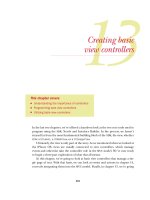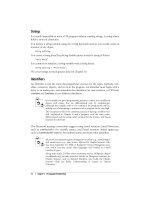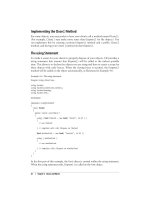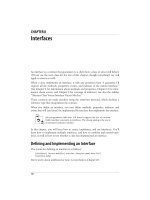Lập trình ứng dụng nâng cao (phần 13) potx
Bạn đang xem bản rút gọn của tài liệu. Xem và tải ngay bản đầy đủ của tài liệu tại đây (248.85 KB, 9 trang )
582 | Index
protected internal access modifier, 65
public access modifier, 65, 66, 566
publish and subscribe design
pattern, 258–266
publishing events, 258, 262–264
Push() method, Stack, 208, 209
Q
queries, ADO.NET, 375, 377
queries, LINQ
caching results of, 284
creating, 280–283, 352
deferred execution of, 283
from clause, 282
grouping, 290
join clause, 285
method-based queries, 298
orderby clause, 286–289
range variable for, 282
select clause (projection), 283, 294
storing results with anonymous
types, 291
where clause (filter), 282
queries, SQL, 371
Queue class, 206
queues, 206–208
quotes (see double quotes; single quotes)
R
race conditions, 485
RAD (Rapid Application Development)
Web Forms for, 381
RaisePostDataChangedEvent() method, 385
range variable, LINQ, 282
Rank property, System.Array, 158
Rapid Application Development (RAD)
Web Forms for, 381
Read() method, Stream, 500
Reader class, ADO.NET, 368
ReadLine() method
Console, 47
StreamReader, 504
readonly fields, 96
readonly modifier, 566
records, relational database, 369
rectangular arrays, 165–169
ref modifier, 566
ref parameter modifier, 83
reference types, objects as, 23, 130
ReferenceEquals() method, Object, 113
reflection, 449, 456
creating types at runtime using, 456
late binding using, 456, 462–464
type discovery using, 456, 458–462
viewing metadata using, 456–457
reflection emit (see types, creating at runtime
using reflection)
Refresh() method, DirectoryInfo, 489
Regex class, 230
Regsvr32 utility, 546
regular expressions, 214, 229–232
capture collections for, 237–240
grouping subexpression matches
of, 234–237
match collections for, 232–234
relational databases, 368–371
constraints, 370
declarative referential integrity (DRI), 370
normalization of, 370
querying with SQL, 371
relational operators, 54
operator precedence for, 57
overloading, required pairs for, 120
remainders in division (see modulus operator
(%))
Remove() method
Dictionary, 212
List, 196
StringBuilder, 227
RemoveAll() method, List, 196
RemoveAt() method, List, 196
RemoveRange() method, List, 196
Render() method, 385
Replace() method, StringBuilder, 227
Resize() method, System.Array, 158
resources
creating, in WPF, 409
freeing, 79–83
locking (see synchronization)
unmanaged, cleaning up, 79, 113
resources (information)
contact information for this book, xvi
(see also books; web site resources)
return statement, 35, 126
return value of methods, 8
Reverse() method
List, 196
System.Array, 158, 175
root element, XML, 303, 307
Root property, DirectoryInfo, 489
Rows collection, ADO.NET, 373
rows, relational database, 369
runat=Server attribute, 391
Index | 583
S
SaveViewState() method, 385
sbyte keyword, 566
sbyte type, 22
screen scraping, 529
sealed classes, 112
sealed keyword, 112
sealed modifier, 566
search conditions (predicates), XPath, 318,
320–321
searching database (see LINQ)
security, with data binding, 398
select clause of query, 283, 294
Select() method, XPathNavigator, 327
SelectNodes() method, XPath, 321
SelectSingleNode() method, XPath, 318,
319, 326
self-assignment operators, 52
Sells, Chris (Programming WPF), 404
semicolon (;)
ending statements, 33
not ending class definitions, 63
Serializable attribute, 529, 531
serialization, 487, 529–538
formatter for, 530
transient data, handling, 535
serialization, XML, 329–331
customizing using attributes, 331–333
deserialization, 331
runtime customization of, 333–336
Serialize() method, formatter, 532
server-side controls
adding to Web Form, 388–391, 399–403
ASP (web) controls, 391
binding to data, 391–398
HTML controls, 391
validation controls, 401
set accessor, 95
set() method, for indexers, 180
SetAttributes() method, File, 492
SetCreationTime() method, File, 492
SetLastAccessTime() method, File, 492
SetLastWriteTime() method, File, 493
SetValue() method, System.Array, 158
shift operator (<<>>), 57
short type, 22
short-circuit evaluation, 56
signature of a method, 89
Silverlight, information about, 6
Simonyi, Charles (inventor of Hungarian
notation), 32
single quotes ('), escape character for, 24
single type, 22
slash (/), in XPath, 318
(see also division operator (/))
slash asterisk (/* */), enclosing
comments, 10
slash, double (//), preceding comments, 9
SOA, book about, 329
SOAP, 530
SoapFormatter class, 530
sockets, 511
software requirements, x
Sort() method
List, 196, 198
System.Array, 158, 175
sorting arrays, 175–177
sorting query results, 286–289
source code for examples, xi
spaces (see whitespace)
specialization, 98–101
Split() method
Regex, 231
String, 218, 226
SQL (Structured Query Language), 371
connecting to database with LINQ (see
LINQ)
LINQ syntax compared to, 285
SQL injection attack, 398
SQL Server 2005 Adventure Works LT
sample database, 338
SQL Server, version used for this book, x
SQML (Structured Query Markup
Language), 304
square brackets (see brackets)
stack (in memory), 23
(see also call stack)
Stack class, 208
stack frame, 23, 242
stack panels, WPF, 406–408, 414
stack trace, 253–255
stackalloc keyword, 566
stacks, 208–211
StackTrace property, Exception, 253
standard output, 11
Start() method, TcpListener, 512, 513
StartRead() method, ClientHandler, 518,
523
starts-with() function, XPath, 321
StartsWith() method, String, 218
state object, asynchronous I/O, 507
state of web application, 384
584 | Index
statement blocks, 37
statements, 33
conditional branching statements, 35–42
iteration statements, 42–49
unconditional branching statements, 34
(see also specific statements)
static classes, 78
static keyword, 14
static members of a class, 14, 75–79
constructors, 76–77
initializers for, 79
member variables
accessibility of, 79
tracking instances using, 78
methods
as global, 75
invoking, 75, 76
passing instance members to, 76
static modifier, 566
statically typed, 21
storage, isolated, 538–541
Stream class, 499
streaming
asynchronous network files, 522–527
network client, 515–518
network server, 513–515
web streams, 527–529
StreamReader class, 504
streams, 487
backing store for, 487
buffered, 502–504
serialization of data for (see serialization)
StreamWriter class, 504, 513
String class, 215
string keyword, 32
string literals, 32, 216
(see also char literals)
string representation of object, 113
StringBuilder class, 227–228
StringReader class, 499
strings, 32, 215, 566
comparing, 221
concatenating, 221
copying, 222
creating with literals, 216
creating with ToString() method, 217
delimiters in, problems with, 229
equality of, testing, 222
finding specific character in, 222
immutable (String class), 215
indexers based on, 183–186
length of, 222
manipulating, 217–223
methods and properties for, 217
mutable (StringBuilder class), 227–228
ordering, 215
parsing into substrings, 226
String type compared to string type, 215
switch statement using, 42
(see also regular expressions; substrings)
StringWriter class, 499
strongly typed, 22
structs, 5, 127, 566
creating, 129–131
defining, 128
performance of, 127
Structured Query Markup Language
(SQML), 304
style guidelines for code, by Microsoft, 14
subdirectories
creating, 496
listing files in, 492–496
traversing, 489–492
subscribe operator (+=), 265, 266
subscribing to events, 258, 264
Substring() method, String, 218, 223–225
substrings
finding at end of string, 222
finding location of, within string, 223
finding within string, 223–225
inserting into a string, 223
parsing string into, 226
subtraction operator (-), 50
subtraction self-assignment operator (-=), 52
support for this book, xv
SuppressFinalize() method, GC, 81
Swann’s Way (Proust), 557
switch keyword, 567
switch statement, 38–42
C and C++ differences in, 41
default case for, 41
on strings, 42
Visual Basic 6 equivalents to, 40
symbolic constants, 28
symbolic values, 50
synchronization, 465, 474–477
Interlocked class for, 477
lock statement for, 479
monitors for, 480–485
(see also thread synchronization)
synchronous I/O, 506
SyncRoot property, System.Array, 158
Index | 585
System.Array type, 157
System.Attribute class, 452
System.IO namespace, 488
System.Object type, 113–115
System.Reflection namespace, 451
System.Threading namespace, 465
System.Web namespace, 382
System.Web.Extension namespace, 382
System.Web.UI namespace, 382
System.Xml namespace, 307
System.Xml.Serialization namespace, 329
System.Xml.XPath namespace, 311, 322
SystemRoot directory, 496
T
\t escape character, in string literal, 216
tables, relational database, 369
tabs
escape characters for, 24
in string literals, 216
(see also whitespace)
tags, XML, 303
targets, of metadata attributes, 450
applying to attributes, 450
list of, 449
TCP/IP protocol, 511
TcpClient class, 515
TcpListener object, 512, 513
ternary operator (?:), 58
text files, 504–506
TextReader class, 499
TextWriter class, 499
ThenBy() method, LINQ, 301
this keyword, 73–74
as documentation, 74
for passing objects as parameters, 74
in indexer declarations, 177, 180
to call overloaded constructors, 74
to qualify instance members, 73
Thread class, 466
thread synchronization, 485
threads, 465
creating, 466
joining, 469
killing, 470–474
scheduling of, 469
starting, 467
suspending (sleeping), 469
uses of, 466
ThreadStart delegate class, 466
throw statement, 242–244
ToArray() method
LINQ, 284
List, 196
Queue, 206
Stack, 209
ToArray() method, Stack, 209
ToList() method, LINQ, 284
ToString() method, Object, 113, 115, 125,
217
ToUpper() method, String, 218
TreeView controls, Windows Forms
event handling for, 429–432
populating, 424–428
triggers, WPF, 411
Trim() method, String, 218
TrimEnd() method, String, 218
TrimExcess() method
List, 196
Queue, 206
Stack, 209
TrimToSize() method, List, 196
TrueForAll() method, System.Array, 158
try block, 244, 246
TryGetValue() method, Dictionary, 212
type conversion
implementing operators for, 121, 124
of built-in types, 24
type discovery, using reflection, 456,
458–462
types, 7, 21
built-in types, 22–25
creating at runtime using reflection, 456
suffixes of numbers indicating, 24
U
uint type, 22, 23
uint16 type, 22
uint32 type, 22
uint64 type, 23
ulong type, 23
UML (Unified Modeling Language), 99
unconditional branching statements, 34
(see also jump statements)
#undef directive, 60
UnderlyingObject property,
XPathNavigator, 327
Unified Modeling Language (UML), 99
586 | Index
unmanaged code, invoking from
C#, 551–554
unmanaged resources, cleaning up, 79, 113
unsafe keyword, 554, 556, 567
unsubscribe operator (-=), 267
unwinding the stack, 242, 246
user-defined types, 21
ushort type, 22, 23
using directive, 13
using keyword, 567
using statement, 82
V
validation controls, 401
value types, 130
Values property, Dictionary, 212
variables, 25–26
assigning values to, 25, 27, 49
declaring, 25
implicitly types local variables, 291
initialization of, avoiding, 86–89
initializing, 25, 27
naming conventions for, 14
on the stack, 23
(see also member variables)
verbatim string literals, 216
versioning, 107
ViewState property, web control, 384
virtual keyword, 102, 567
(see also overriding methods)
Visual Basic 6
ADO compared to ADO.NET, 369
array size, differences in, 159
controls, differences in, 425
Dim and New performance penalty, no
equivalent to, 68
loop variable differences, 46
optional parameter equivalents, 67
pointers in, compared to this keyword, 73
Static keyword, compared to C# static
keyword, 75
switch statement eqivalents in, 40
variables in try blocks, restrictions
on, 253
Visual Studio
compiling programs, 17
creating projects, 15
debugger (see debugger)
importing ActiveX controls using, 547
LINQ to SQL designer, 344–348
namespaces included by default, 13, 16
version used for this book, x
web-based applications created
using, 382, 385
W
web controls (see ASP controls)
Web Forms, 381–383
code separation used by, 382
code-behind pages for, 381, 386–388
controls for (see server-side controls)
creating, 385–391
event handlers for, 383
events in, 383, 399–403
life cycle of, 384
web site resources
Adventure Works LT sample
database, 338
author, xi, xv
code style guidelines by Microsoft, 14
for this book, xvi
Griffiths, Ian, blog for, 301
Hungarian notation, 32
Northwind database, 369
port numbers, 512
Project Gutenberg, 557
security, 398
Silverlight, 6
source code for examples, xi
support, xv
XPath, 320
XPath functions, 322
web streams, 527–529
web-based applications
advantages of, 381
state of, 384
Visual Studio used for, 382
(see also ASP.NET; Web Forms)
Index | 587
WebRequest object, 527
WebResponse object, 527
where clause of query, 282
Where() method, LINQ, 293
while keyword, 568
while loop, 43
whitespace, 33, 47
Wiltamuth, Scott (C# creator), 4
Windows Forms applications
controls
button, 432–437
creating, 421
populating, 424–428
TreeView, 424–432
creating, 420–421
event handlers for, 423, 429–437
Windows Presentation Foundation (see
WPF)
Windows Vista
protected files, accessing, 492, 496
version used for this book, x
WPF (Windows Presentation
Foundation), 101
books about, 404
creating applications, 405–408
data for application, 412, 414
declarative nature of, 419
event handling in, 418
grids, 406–408, 414
instantiating objects declaratively, 413
resources, creating, 409
stack panels, 406–408, 414
triggers in, 411
Windows version required for, x
Write() method, Console, 46
WriteLine() method
Console, 11, 26, 506
StreamWriter, 504, 506
X
XAML (eXtensible Application Markup
Language), 6, 404
XAttribute class, 363
XDocument class, 363
XElement class, 363
XHTML, 304
Xie, Donald (author), x
XML (eXtensible Markup Language), 302,
304
creating documents, 304–311
elements in, 303
LINQ output to, 363–367
tags in, 303
versions of, 302
XML editor, 309
XML serialization, 329–331
customizing using attributes, 331–333
deserialization, 331
runtime customization of, 333–336
XmlAttribute object, 309
XmlAttributeAttribute object, 333, 335
XmlAttributeOverrides class, 335
XML-based documentation, comments
for, 11
XmlNode class, 318
XmlSerializer object, 330
XPath, 311–317
functions for, 321
search conditions (predicates) for, 318,
320–321
searching for a node, 318–319
searching using axes, 319
searching using
XPathNavigator, 322–328
web site about, 320, 322
XPathExpression object, 328
XPathNavigator class, 322, 326
XPathNodeIterator object, 327
About the Authors
Jesse Liberty, currently a senior program manager on the Silverlight Development
Team at Microsoft, is the author of Programming .NET 3.5, Learning ASP.NET with
AJAX (both for O’Reilly), and many other books. He is a recognized .NET expert
whose experience includes working as a software architect at PBS and as a distin-
guished software engineer at AT&T. He can be reached at .
Donald Xie has been programming since Apple II was known as state of the art. He
has written a lot of applications using different languages and technologies. Since the
late 90s, Donald has focused on developing enterprise-strength business applica-
tions using Microsoft technologies—especially with .NET—from the very first beta.
Donald is a coauthor of several books, including Pro Visual Studio .NET (Apress),
and Fast Track ADO.NET and Data-Centric .NET Programming with C# (both for
Peer Information, Inc.). He has also written books on C++ and Visual Basic.
Currently, Donald works as a business analyst for Chevron.
Colophon
The animal on the cover of Programming C# 3.0, Fifth Edition, is an African
crowned crane. This tall, skinny bird wanders the marshes and grasslands of West and
East Africa (the Western and Eastern African crowned cranes are known as Balearica
pavonia pavonia and Balearica regulorum gibbericeps, respectively).
Adult birds stand about three feet tall and weigh six to nine pounds. Inside their long
necks is a five-foot long windpipe—part of which is coiled inside their breastbone—
giving voice to loud calls that can carry for miles. They live for about 22 years,
spending most of their waking hours looking for the various plants, small animals,
and insects they like to eat. (One crowned crane food-finding technique, perfected
during the 38 to 54 million years these birds have existed, is to stamp their feet as
they walk, flushing out tasty bugs.) They are the only type of crane to perch in trees,
which they do at night when sleeping.
Social and talkative, African crowned cranes group together in pairs or families, and
the smaller groups band together in flocks of more than 100 birds. Their elaborate
mating dance has served as a model for some of the dances of local people.
The cover image is an original engraving from the 19th century. The cover font is
Adobe ITC Garamond. The text font is Linotype Birka; the heading font is Adobe
Myriad Condensed; and the code font is LucasFont’s TheSans Mono Condensed.









